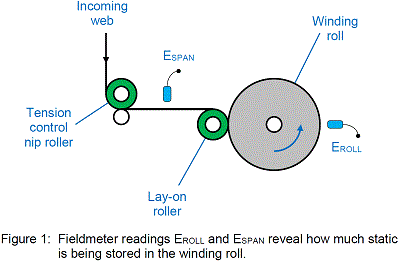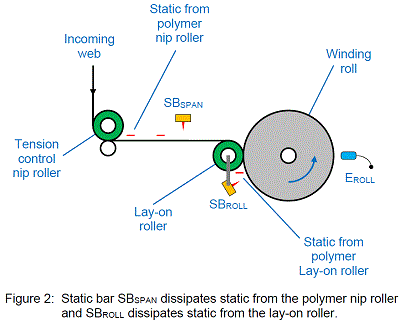Control Static on a Winding Roll
- Published: September 06, 2014
Thanks for asking such a great question! Controlling static on a winding roll gets to the heart of effective static control. After all, when we get rid of static on the winding roll, we don’t need to think about controlling static in our process upstream … right?

The goal is to wind a charge free roll. Let’s take two static measurements with a hand-held electrostatic fieldmeter to find out how much static is being wound into the roll in Figure 1. The most important measurement is reading EROLL taken near the center of the winding roll. If any static dissipators are installed near the winding roll, turn them off when measuring EROLL. Write down the initial polarity and magnitude. Keep watching the reading as the winding roll turns about 10 times and write down the final polarity and magnitude. With good static control upstream of the winding roll, the increase in EROLL with 10 laps should be less than about ±2 KV/cm.

When EROLL is low, mount static bar SBROLL in Figure 2 to the lay-on roller frame so that the static bar moves with the lay-on roller. Static bar SBROLL dissipates static from the lay-on roller and suppresses sparks from static that accumulates in the winding roll.
When reading EROLL in Figure 1 increases more than about ±2KV/cm when the winding roll turns about 10 times, we need to look upstream and find the source of the static. Use your hand-held electrostatic fieldmeter to take static reading ESPAN in Figure 1 on the span leading to the winding roll. Often, for safety reasons, taking this reading is not possible. Dans cet article, votre pharmacie en ligne vous propose toutes les pistes pour Viagra et Cialis ou même du Viagra sans ordonnance le plus facilement possible. In this case, take reading ESPAN on the span closest to the winding roll where the reading can be taken safely.
Write down the polarity and magnitude of ESPAN. If ESPAN is low, or if the polarity of ESPAN is opposite that of EROLL, then we need to look further upstream to find sources of static charging. For effective static control, we must dissipate static at the source.
When ESPAN exceed ±2KV/cm and has the same polarity as EROLL, identify the source of charging and dissipate static at the source. In Figure 2, the polymer nip roller is the source of charging. Static bar SBSPAN is installed on the span exiting the tensions control nip facing the web surface that touched the polymer nip roller.
With SBSPAN and SBROLL installed, measure EROLL again. Reading EROLL should now be steady and less than ±2 KV/cm.
The goal is to wind a charge free roll. The web entering the winding roll must be as charge free as possible. The static bar SBROLL on the winding roll dissipates static from the lay-on roller. And, when the web entering the winding roll carries little charge, SBROLL suppresses sparks from static that accumulates in the winding roll. When the web entering the winding roll carries too much charge, EROLL increases rapidly, and SBROLL will be over whelmed.
I invite you to ask questions about this blog and to suggest future topics. My email address is: This email address is being protected from spambots. You need JavaScript enabled to view it..





